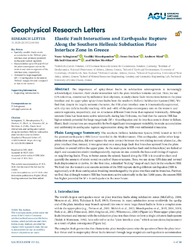Elastic Fault Interactions and Earthquake Rupture Along the Southern Hellenic Subduction Plate Interface Zone in Greece
Mertikas, Stelios
DOI: https://doi.org/10.1029/2019GL086604
Persistent URL: http://resolver.sub.uni-goettingen.de/purl?gldocs-11858/9436
Persistent URL: http://resolver.sub.uni-goettingen.de/purl?gldocs-11858/9436
Saltogianni, Vasso; Mouslopoulou, Vasiliki; Oncken, Onno; Nicol, Andrew; Gianniou, Michail; Mertikas, Stelios, 2020: Elastic Fault Interactions and Earthquake Rupture Along the Southern Hellenic Subduction Plate Interface Zone in Greece. In: Geophysical Research Letters, Band 47, 13, DOI: 10.1029/2019GL086604.
 |
Dokument öffnen: |
The importance of splay-thrust faults in subduction seismogenesis is increasingly acknowledged; however, their elastic interaction with the plate interface remains unclear. Here, we use GPS velocities, constrained by millennial fault slip rates, to study elastic fault-interactions between the plate interface and its upper-plate splay-thrust faults from the southern Hellenic Subduction System (HSS). We find that, despite its largely aseismic character, the HSS plate interface zone is kinematically segmented, with slip rate deficits locally reaching ~85% and ~45% of the plate convergence rate on the western and eastern segments, respectively, and on structures different from those that ruptured historically. Although western Crete has been more active seismically during late Holocene, we find that the eastern HSS has higher seismic potential for large-magnitude (M > 6) earthquakes and its interface zone is closer to failure. Elastic fault interactions are responsible for both significant intersegment variability in strain accumulation and uniformity in earthquake rupture segmentation along the HSS over millennial timescales.
Statistik:
ZugriffsstatistikSammlung:
Schlagworte:
subduction seismogenesisGPS
locking degree
fault interactions
earthquake rupture segmentation
This is an open access article under the terms of the Creative Commons Attribution-NonCommercial-NoDerivs License, which permits use and distribution in any medium, provided the original work is properly cited, the use is non-commercial and no modifications or adaptations are made.

